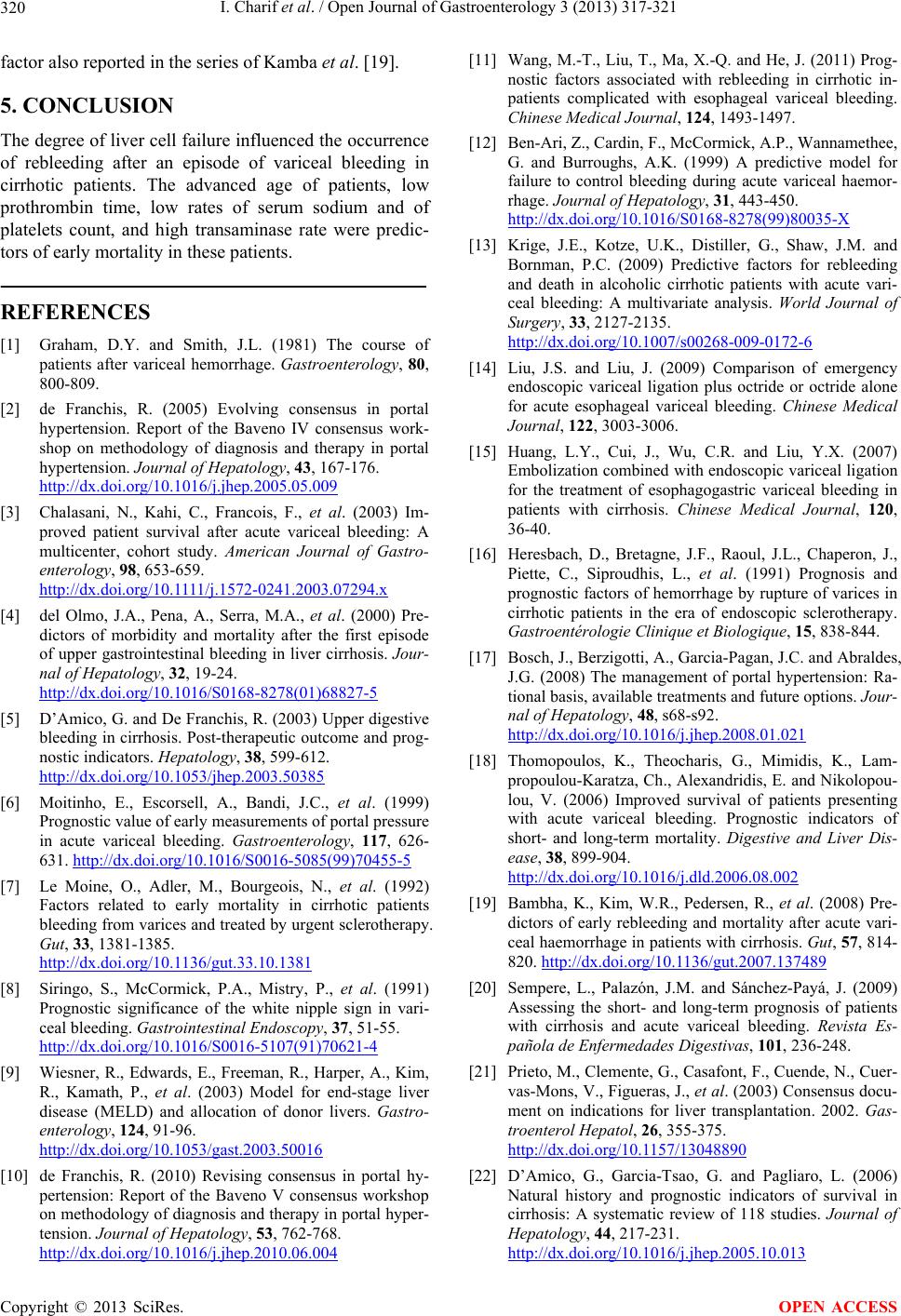
I. Charif et al. / Open Journal of Gastroenterology 3 (2013) 317-321
320
factor also reported in the series of Kamba et al. [19].
5. CONCLUSION
The degree of liver cell failure influenced the occurrence
of rebleeding after an episode of variceal bleeding in
cirrhotic patients. The advanced age of patients, low
prothrombin time, low rates of serum sodium and of
platelets count, and high transaminase rate were predic-
tors of early mortality in these patients.
REFERENCES
[1] Graham, D.Y. and Smith, J.L. (1981) The course of
patients after variceal hemorrhage. Gastroenterology, 80,
800-809.
[2] de Franchis, R. (2005) Evolving consensus in portal
hypertension. Report of the Baveno IV consensus work-
shop on methodology of diagnosis and therapy in portal
hypertension. Journal of Hepatology, 43, 167-176.
http://dx.doi.org/10.1016/j.jhep.2005.05.009
[3] Chalasani, N., Kahi, C., Francois, F., et al. (2003) Im-
proved patient survival after acute variceal bleeding: A
multicenter, cohort study. American Journal of Gastro-
enterology, 98, 653-659.
http://dx.doi.org/10.1111/j.1572-0241.2003.07294.x
[4] del Olmo, J.A., Pena, A., Serra, M.A., et al. (2000) Pre-
dictors of morbidity and mortality after the first episode
of upper gastrointestinal bleeding in liver cirrhosis. Jour-
nal of Hepatology, 32, 19-24.
http://dx.doi.org/10.1016/S0168-8278(01)68827-5
[5] D’Amico, G. and De Franchis, R. (2003) Upper digestive
bleeding in cirrhosis. Post-therapeutic outcome and prog-
nostic indicators. Hepatology, 38, 599-612.
http://dx.doi.org/10.1053/jhep.2003.50385
[6] Moitinho, E., Escorsell, A., Bandi, J.C., et al. (1999)
Prognostic value of early measurements of portal pressure
in acute variceal bleeding. Gastroenterology, 117, 626-
631. http://dx.doi.org/10.1016/S0016-5085(99)70455-5
[7] Le Moine, O., Adler, M., Bourgeois, N., et al. (1992)
Factors related to early mortality in cirrhotic patients
bleeding from varices and treated by urgent sclerotherapy.
Gut, 33, 1381-1385.
http://dx.doi.org/10.1136/gut.33.10.1381
[8] Siringo, S., McCormick, P.A., Mistry, P., et al. (1991)
Prognostic significance of the white nipple sign in vari-
ceal bleeding. Gastrointestinal Endoscopy, 37, 51-55.
http://dx.doi.org/10.1016/S0016-5107(91)70621-4
[9] Wiesner, R., Edwards, E., Freeman, R., Harper, A., Kim,
R., Kamath, P., et al. (2003) Model for end-stage liver
disease (MELD) and allocation of donor livers. Gastro-
enterology, 124, 91-96.
http://dx.doi.org/10.1053/gast.2003.50016
[10] de Franchis, R. (2010) Revising consensus in portal hy-
pertension: Report of the Baveno V consensus workshop
on methodology of diagnosis and therapy in portal hyper-
tension. Journal of Hepatology, 53, 762-768.
http://dx.doi.org/10.1016/j.jhep.2010.06.004
[11] Wang, M.-T., Liu, T., Ma, X.-Q. and He, J. (2011) Prog-
nostic factors associated with rebleeding in cirrhotic in-
patients complicated with esophageal variceal bleeding.
Chinese Medical Journal, 124, 1493-1497.
[12] Ben-Ari, Z., Cardin, F., McCormick, A.P., Wannamethee,
G. and Burroughs, A.K. (1999) A predictive model for
failure to control bleeding during acute variceal haemor-
rhage. Journal of Hepatology, 31, 443-450.
http://dx.doi.org/10.1016/S0168-8278(99)80035-X
[13] Krige, J.E., Kotze, U.K., Distiller, G., Shaw, J.M. and
Bornman, P.C. (2009) Predictive factors for rebleeding
and death in alcoholic cirrhotic patients with acute vari-
ceal bleeding: A multivariate analysis. World Journal of
Surgery, 33, 2127-2135.
http://dx.doi.org/10.1007/s00268-009-0172-6
[14] Liu, J.S. and Liu, J. (2009) Comparison of emergency
endoscopic variceal ligation plus octride or octride alone
for acute esophageal variceal bleeding. Chinese Medical
Journal, 122, 3003-3006.
[15] Huang, L.Y., Cui, J., Wu, C.R. and Liu, Y.X. (2007)
Embolization combined with endoscopic variceal ligation
for the treatment of esophagogastric variceal bleeding in
patients with cirrhosis. Chinese Medical Journal, 120,
36-40.
[16] Heresbach, D., Bretagne, J.F., Raoul, J.L., Chaperon, J.,
Piette, C., Siproudhis, L., et al. (1991) Prognosis and
prognostic factors of hemorrhage by rupture of varices in
cirrhotic patients in the era of endoscopic sclerotherapy.
Gastroentérologie Clinique et B i o l o g i q u e, 15, 838-844.
[17] Bosch, J., Berzigotti, A., Garcia-Pagan, J.C. and Abraldes,
J.G. (2008) The management of portal hypertension: Ra-
tional basis, available treatments and future options. Jour-
nal of Hepatology, 48, s68-s92.
http://dx.doi.org/10.1016/j.jhep.2008.01.021
[18] Thomopoulos, K., Theocharis, G., Mimidis, K., Lam-
propoulou-Karatza, Ch., Alexandridis, E. and Nikolopou-
lou, V. (2006) Improved survival of patients presenting
with acute variceal bleeding. Prognostic indicators of
short- and long-term mortality. Digestive and Liver Dis-
ease, 38, 899-904.
http://dx.doi.org/10.1016/j.dld.2006.08.002
[19] Bambha, K., Kim, W.R., Pedersen, R., et al. (2008) Pre-
dictors of early rebleeding and mortality after acute vari-
ceal haemorrhage in patients with cirrhosis. Gut, 57, 814-
820. http://dx.doi.org/10.1136/gut.2007.137489
[20] Sempere, L., Palazón, J.M. and Sánchez-Payá, J. (2009)
Assessing the short- and long-term prognosis of patients
with cirrhosis and acute variceal bleeding. Revista Es-
pañola de Enfermedades Digestivas, 101, 236-248.
[21] Prieto, M., Clemente, G., Casafont, F., Cuende, N., Cuer-
vas-Mons, V., Figueras, J., et al. (2003) Consensus docu-
ment on indications for liver transplantation. 2002. Gas-
troenterol Hepatol, 26, 355-375.
http://dx.doi.org/10.1157/13048890
[22] D’Amico, G., Garcia-Tsao, G. and Pagliaro, L. (2006)
Natural history and prognostic indicators of survival in
cirrhosis: A systematic review of 118 studies. Journal of
Hepatology, 44, 217-231.
http://dx.doi.org/10.1016/j.jhep.2005.10.013
Copyright © 2013 SciRes. OPEN ACCESS